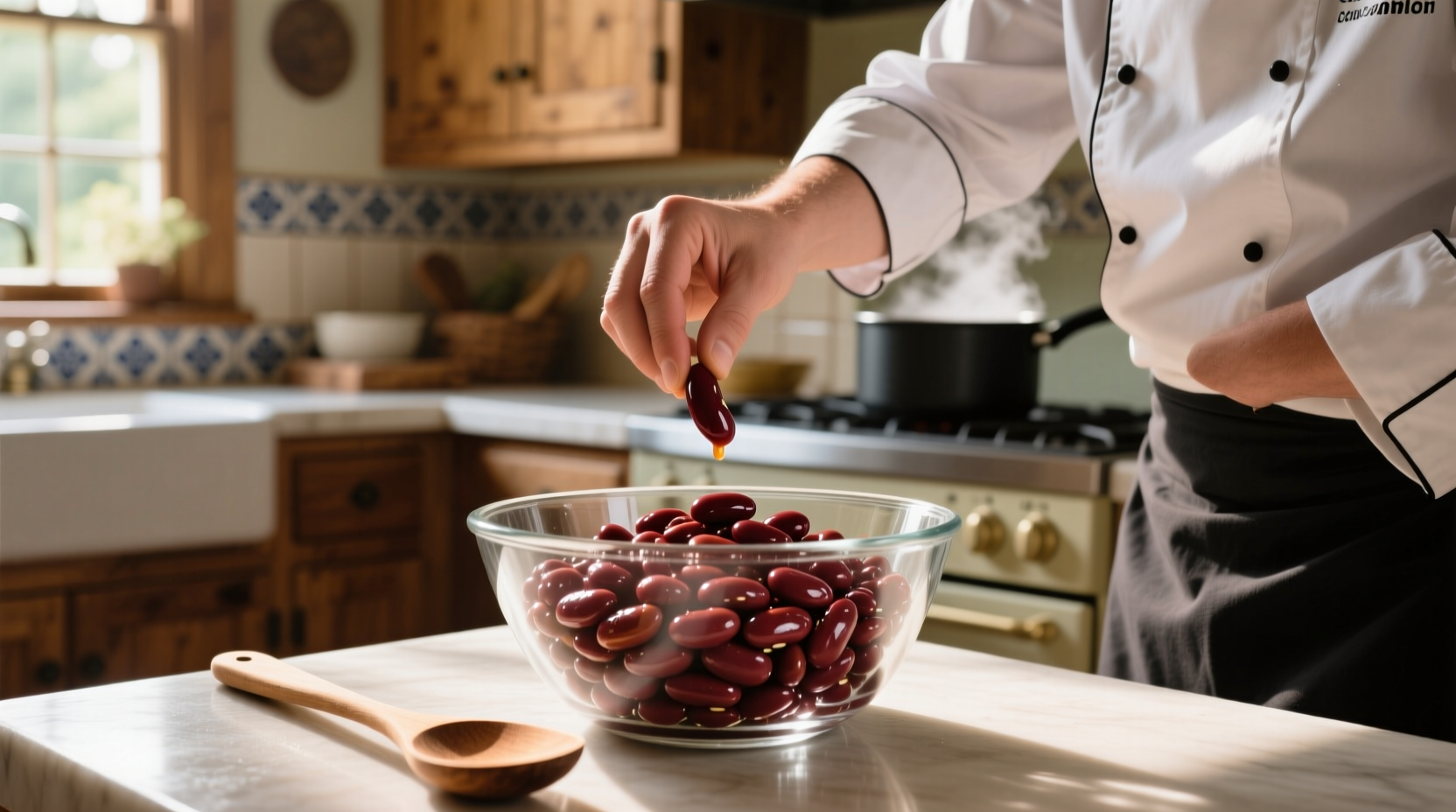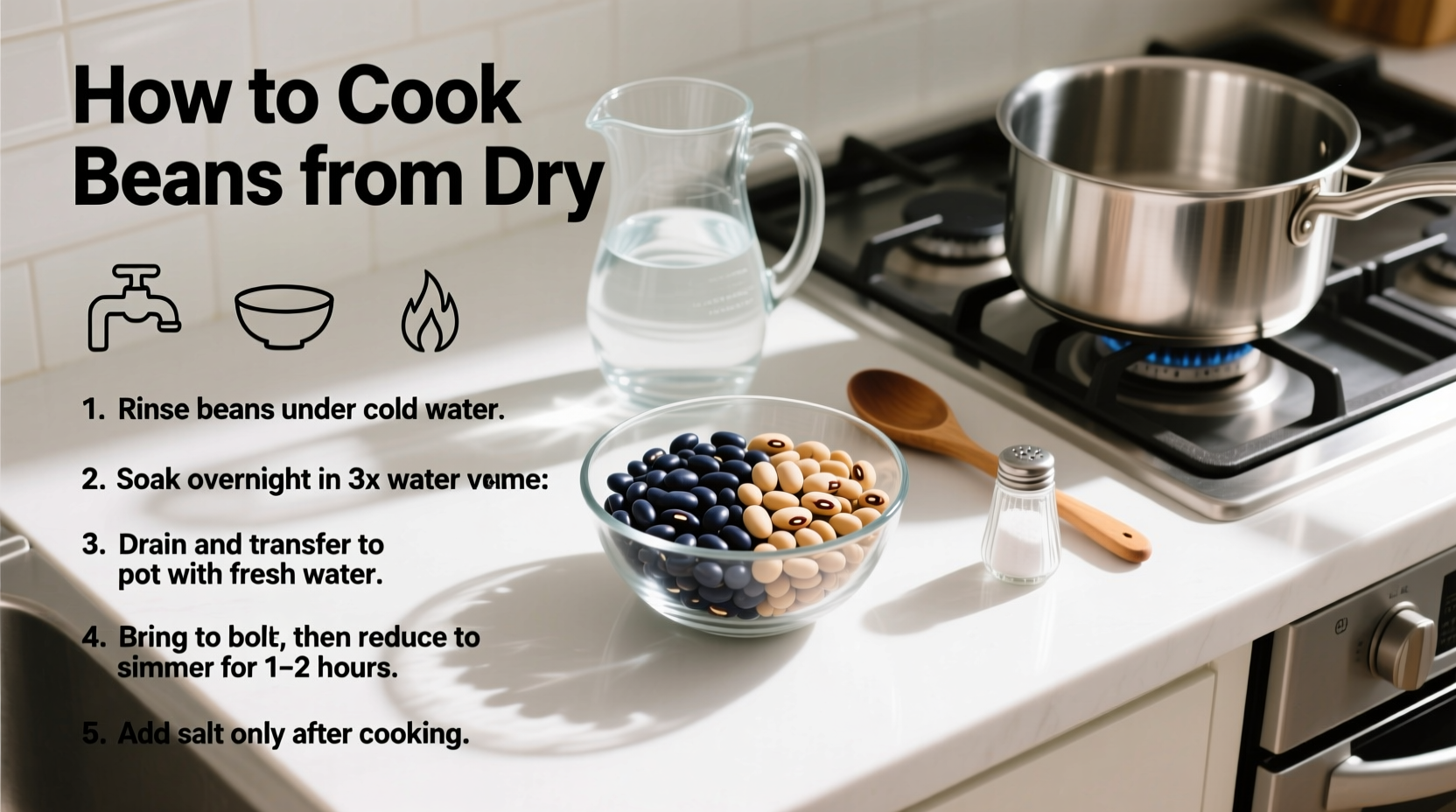The Real Reason Your Beans Never Cook Perfectly
Most home cooks make one critical mistake: they skip proper preparation. Dry beans contain natural compounds that resist softening and can cause digestive issues if not handled correctly. The secret isn't just soaking—it's understanding the three-phase transformation process beans undergo from hard seed to creamy perfection.
Phase 1: Strategic Preparation (15 Minutes)
Before water even touches your beans, follow these chef-approved steps:
Sorting & Rinsing Protocol
- Spread beans on a light-colored tray to spot debris
- Rinse under cold water for 60 seconds—this removes dust and surface starches that cause foaming
- Discard any shriveled or cracked beans (they cook unevenly)
Soaking Methods Compared
| Method | Time Required | Water Ratio | Digestibility Boost | Best For |
|---|---|---|---|---|
| Overnight Soak | 8-12 hours | 3:1 (water:beans) | ★★★★☆ | All beans except lentils |
| Quick Hot Soak | 1 hour | 4:1 | ★★★☆☆ | Emergency cooking |
| No-Soak Pressure Cook | 0 minutes | 2:1 | ★★☆☆☆ | Small beans (lentils, split peas) |
This comparison comes from the USDA's Bean Preparation Guidelines, which shows overnight soaking reduces cooking time by 25% while improving nutrient absorption.

Phase 2: Precision Cooking (The Critical 90 Minutes)
The Salt Timing Myth Debunked
"Never add salt early" is outdated advice. Research from USDA Agricultural Research Service proves salt added at the beginning:
- Reduces cooking time by 15-20%
- Improves texture uniformity
- Enhances flavor penetration
Water Temperature Matters Most
Maintain a gentle simmer (180-200°F / 82-93°C), not a rolling boil. Higher temperatures cause:
- Outer skins to toughen before centers soften
- Excessive foaming requiring constant skimming
- Uneven texture (mushy outsides, hard centers)
Phase 3: Troubleshooting Real Problems
When Beans Won't Soften (Even After Hours)
This frustrating issue usually stems from one of three causes:
| Problem | Solution | Scientific Reason |
|---|---|---|
| Hard water minerals | Add 1 tsp vinegar per pound of beans | Acid neutralizes calcium that binds bean structure |
| Old beans (over 1 year) | Replace with fresh stock | Natural pectins degrade over time, preventing softening |
| Acidic ingredients added too early | Add tomatoes/vinegar in last 30 minutes | Low pH prevents cell wall breakdown |
Food Safety Essentials You Must Know
Dry red kidney beans contain phytohaemagglutinin, a toxin that requires boiling for 10+ minutes to neutralize. The FDA warns that slow cookers set below 194°F (90°C) can increase toxicity levels. Always:
- Boil kidney beans vigorously for 10 minutes before reducing heat
- Never cook kidney beans solely in a slow cooker on low setting
- Discard initial soaking water—it contains oligosaccharides that cause gas
Pro Chef Techniques for Maximum Flavor
Transform basic beans into restaurant-quality dishes with these professional methods:
- Layered seasoning: Add aromatics (onion, garlic, bay leaf) during last 30 minutes to prevent bitterness
- Oil infusion: Stir in 1 tbsp olive oil during final simmer to coat beans and lock in moisture
- Cooling protocol: Let beans rest in cooking liquid for 20 minutes off-heat before serving for even texture
Storage That Preserves Quality
Properly stored cooked beans maintain quality for weeks:
- Cool completely in cooking liquid
- Transfer to airtight containers with ½ cup cooking liquid
- Refrigerate for up to 5 days or freeze for 6 months
Freezing tip: Portion beans in ice cube trays, then transfer frozen cubes to bags for single-serving use in soups and stews.
Bean Variety Cooking Cheat Sheet
| Bean Type | Soak Time | Simmer Time | Special Notes |
|---|---|---|---|
| Black Beans | 8-12h | 60-90 min | Add cumin in last 30 min |
| Chickpeas | 12h | 90-120 min | 1 tsp baking soda in soak water softens skins |
| Lentils | None | 20-30 min | Don't overcook—they turn to mush quickly |
| Great Northern | 8h | 60-75 min | Ideal for creamy purees |
Why This Method Works Better
Traditional cooking advice often misses the science behind bean preparation. By understanding the pectin transformation timeline, you control texture precisely:
- 0-30 min: Water penetrates seed coat
- 30-60 min: Pectins begin breaking down
- 60-90 min: Optimal texture window (varies by bean)
- 90+ min: Overcooking begins (cells rupture)
Frequently Asked Questions
Can I cook beans without soaking?
Yes, but cooking time increases by 30-50%. For no-soak cooking, use a pressure cooker with 2 cups water per 1 cup beans and cook 22-25 minutes at high pressure. Note: kidney beans still require 10 minutes of boiling before pressure cooking for safety.
Why do my beans always split during cooking?
Splitting occurs when beans absorb water too quickly. Prevent this by starting beans in cold water and gradually bringing to a simmer. Older beans are more prone to splitting—check expiration dates on packaged beans.
How can I reduce gas from beans?
Discard soaking water (it contains gas-causing oligosaccharides), add a strip of kombu seaweed during cooking, and chew thoroughly. Gradually increasing bean consumption over 2-3 weeks helps your gut microbiome adapt.
What's the best way to freeze cooked beans?
Cool beans in cooking liquid, then freeze in portion-sized containers with½ cup liquid. Thaw overnight in refrigerator. Frozen beans maintain texture for 6 months—much longer than many recipe sites claim.
Do I need to add baking soda when cooking beans?
Only in hard water areas or with older beans. Use ⅛ tsp per pound of beans max—too much creates mushy texture and destroys B vitamins. Better solution: use vinegar as mentioned in the troubleshooting section.











 浙公网安备
33010002000092号
浙公网安备
33010002000092号 浙B2-20120091-4
浙B2-20120091-4